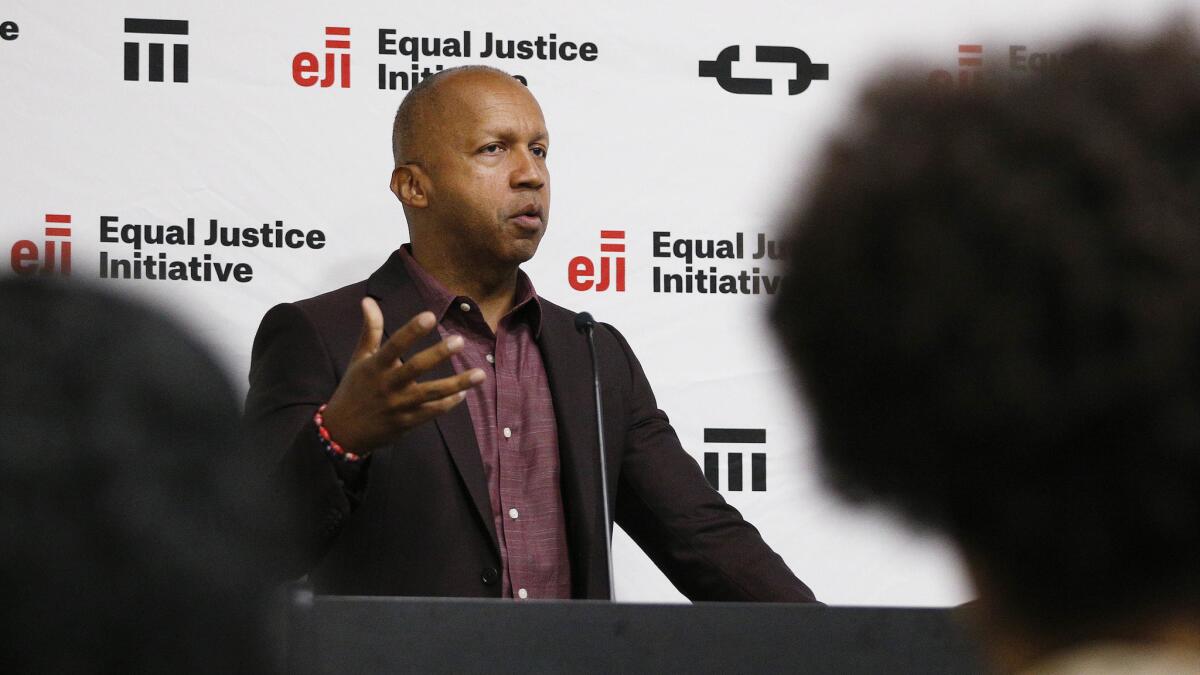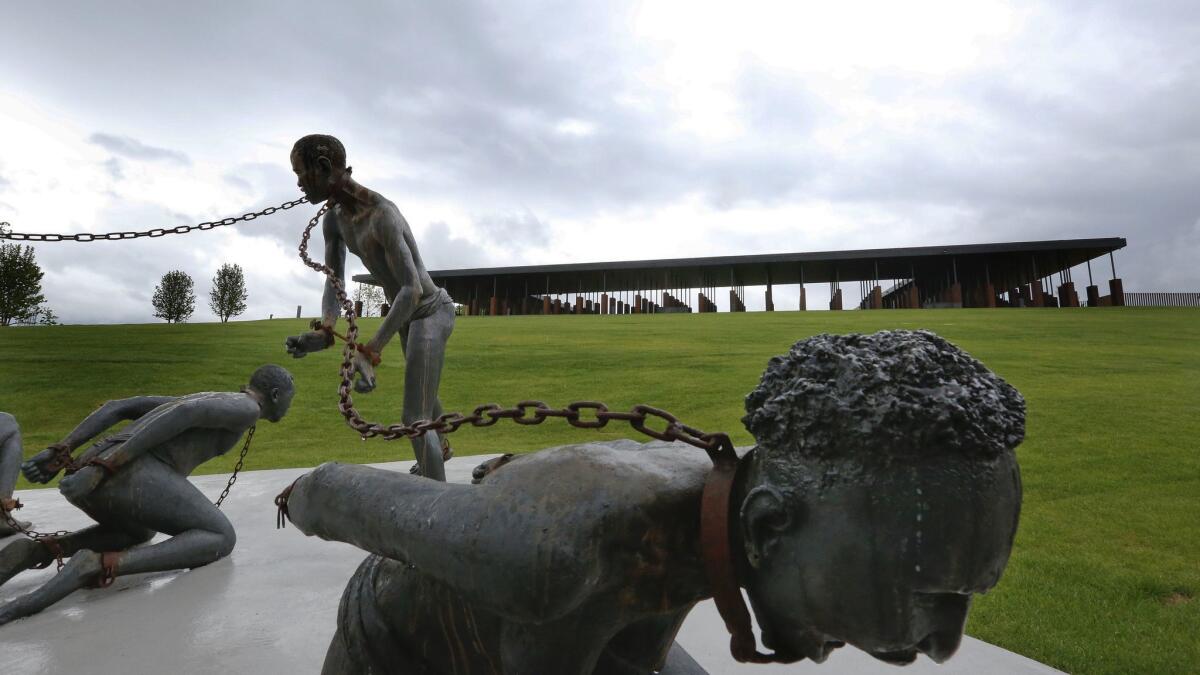Q&A: âCapital punishment is the stepchild of lynching.â Hereâs what Bryan Stevenson hopes to address with a memorial honoring black people who were killed

Bryan Stevenson wants people to examine an era of American history that goes ignored â a chapter often left untold. It was a time, he says, of domestic terrorism.
Between 1877 and 1950, more than 4,400 black people died by lynching, according to statistics compiled by the Equal Justice Initiative, a nonprofit organization that provides legal representation to inmates and works to alleviate racial and economic injustice.
On Thursday, the group founded by Stevenson will open the National Memorial for Peace and Justice in Montgomery, Ala., the country's first site dedicated to the legacy of black people lynched in the United States.
Stevenson, a 58-year-old lawyer, spoke with The Times recently about the memorial, race relations, and how he sees capital punishment as a modern form of lynching. The interview has been edited for length and clarity.
First, why did you choose to focus on lynchings for this memorial?
The era of racial terror is the era that is least understood in American history. After the emancipation of enslaved black people, there was this period of violence and terror and it was tragic. Enslaved people were promised freedom and what they got was terrorism and it was horrific. And I don't think we've acknowledged it. I don't think we've talked about it. More than 6 million people fled the American South during this period of time, and the demographic geography of our nation was shaped by this violence. Black people in L.A., the black people in Cleveland and Chicago and Detroit went to these communities not as immigrants, but as refugees and exiles from terror. And many of the contemporary issues are shadowed by this exodus from the American South, which was a direct response to terrorism and lynching. So, for me, if you skip from the Civil War to civil rights you're not going to understand either. And I just felt like this was a part of our history that we needed to address.
You want officials from U.S. counties where lynchings took place â mostly in the South, but all over the country â to come and claim a column from the memorial and put it on display in their county. This is an effort to show accountability?
Yes, I believe in truth and reconciliation, and we haven't been truthful about our history of racial inequality. I think that truth and reconciliation is sequential. You've got to first tell the truth about what happened and then you can begin to understand what is required to recover, to make repairs, to restore, to reconcile. And I don't want to deny any county in America that has a history of lynching an opportunity to localize this project, this effort. We have spaces in this country where the legacy of terrorism and lynching still burdens people. People of color feel menaced. There is still a presumption of dangerousness and guilt that gets assigned to black and brown people. One of the ways we can overcome these contemporary issues and problems is if we understand the history, the legacy, the circumstances that gave rise to this more clearly. So I think communities ought to have a chance to begin conversations, to facilitate dialogue that might lead them to understand the importance of bringing back their monuments â erecting [the column] in a public space and allowing others to encounter this history in a more sober and thoughtful way.
You've represented hundreds of inmates facing execution â some who have been wrongfully convicted. In a 2016 New Yorker piece, you, in a way, compared lynchings to modern day executions. Can you talk about that?
The threat that lynching represents is a threat rooted in a narrative of racial difference. I don't believe the great evil of American slavery was involuntary servitude and forced labor. I really do believe that the great evil of American slavery was this narrative of racial difference. This ideology of white supremacy. Our 13th Amendment ended involuntary servitude and forced labor, but it did not end this narrative of racial difference. Because of that I don't think slavery ended, I think it just evolved and that's what created decades of terrorism and lynching. In the 1940s and 1950s when soldiers were returning from World War II, the spectacle of lawlessness in the American South, the reckless way in which we were disregarding the Constitution and the rule of law, exposed America to our international allies. It made us seem like it was just rhetoric when we talked about justice and fairness. So pressure was placed on these communities to eliminate these optics. And what happened was that lynchings moved inside. We still executed mostly black people after proceedings that were unreliable and unfair. We promised âswift justice,â which was intended to be the same thing as lynching without the spectacle, without the optic, without the mob. And in that respect, I do believe that capital punishment is the stepchild of lynching. It was disproportionately used against people of color; it still continues to be shaped primarily by race.
What's the biggest problem facing our criminal justice system at this moment?
I think the size of it. I think the misguided war on drugs that we declared in 1970s and â80s is the part that has to be addressed immediately. We declared drug addiction, drug dependency to be a crime rather than a healthcare problem, and we threw hundreds of thousands of people into jails and prisons. That's the primary reason why the prison population has skyrocketed, that we now have the highest rate of incarceration in the world. That we've gone from spending $6 billion on jails and prisons in 1980, to $80 billion last year reveals that we have created an epidemic of incarcerations. So reducing the size and scale of the system for me is the top priority. One in three black male babies born in this country is expected to go to jail or prison during his lifetime. That has to change if we're going to have a healthy society.

You and others have talked about how lynchings of black people were domestic terrorism. What, in your eyes, equates domestic terrorism today?
Violence directed at a group, to terrorize the entire group, not just a particular person, is what most people think of as terrorism. It's interesting, older people of color come up to me sometimes and they say, âMr. Stevenson, I get angry when I hear someone talk about how we're dealing with domestic terrorism for the first time in our nation's history after 9/11.â They say, âWe grew up with terror. We had to worry about being bombed and lynched and menaced,â and the absence of recognition of that terrorism aggravates the burden, the weight of this problem. For me, acknowledging this era becomes even more critical.
Has President Trump and some of his rhetoric set us back when it comes to race relations?
I don't think there is any question that when you have elected officials using race as an organizing concept for how people should be thought of, when you engage in the politics of fear and anger, it's going to be a setback. I think fear and anger are the essential ingredients of injustice and inequality and oppression. We have to resist, we have to reject that kind of narrative, banning people because they are Muslim. Denigrating people because they're Mexican is racial bigotry and we can't tolerate that. We can't accept that. And whether it's the president or any local official, we have to create a conscience in this country where no person running for office thinks it's going to benefit them to engage in that kind of discourse. And the reason why we haven't gotten there yet is because we haven't adequately educated people about this history, about this violence. There are no Adolf Hitler statues in Germany; most elected officials do everything they can to acknowledge the history of the Holocaust. Nobody is saying âMake Germany Great Againâ by invoking the period of the 1930s and 1940s. I don't think that would be an acceptable narrative to people in Europe and to most Germans. And I just don't think we have done the same kind of work to raise the consciousness about our history of slavery, about our history of lynching, our history of segregation. As an African American, what decade am I supposed to want to relive that is the glorious era in the United States?
If you had one hope for what a young boy or girl might leave with after visiting the memorial, what would it be?
I went the Holocaust museum in Washington and I went through that experience and when I finished I was motivated to say, along with those who had said it before me, never again. It evoked in me a consciousness about the horrors of genocide and mass violence that made me unequivocally committed to do what I can to keep that from happening. We haven't created cultural institutions in this country that present the history of our nation and the burden of racial inequality and the mistreatment of African Americans in a way that motivates people to say, ânever again.â Because we haven't made that commitment, we continue to see manifestations of bias and discrimination. I hope the young kids that come to our museum, that come to our memorial, will leave these places prepared to say, âNever again shall we allow anything that replicates the legacy of slavery or lynching or segregation or bigotry. Never again can we allow our nation to be shaped by people who harbor bias and racial judgments that are unfair and bigoted.â
Sign up for Essential California
The most important California stories and recommendations in your inbox every morning.
You may occasionally receive promotional content from the Los Angeles Times.








